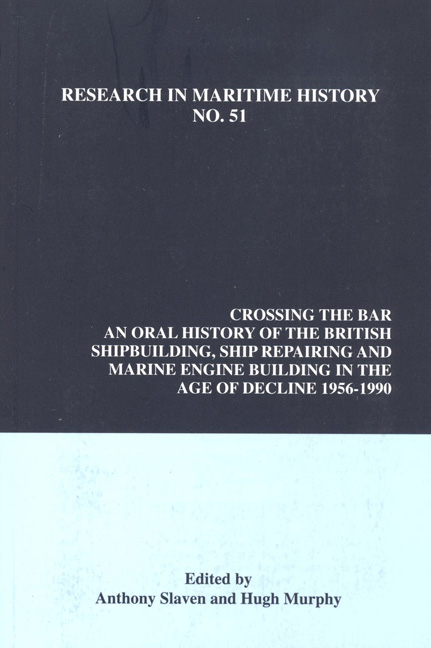 Crossing the Bar
Crossing the Bar Book contents
- Frontmatter
- Contents
- About the Authors
- Dedication
- Preface: A Shipbuilding Libretto
- Introduction
- Interviews
- Lower Clyde
- Upper Clyde
- The Tyne
- The Wear
- Barrow-in-Furness
- 26 Bill Richardson, Vickers Armstrong, Swan Hunter, British Shipbuilders Pic
- 27 Roy Turner, Vickers
- The South Coast
- The Humber
- Belfast
- British Shipbuilding Industry Officials
- The Trade Unions
- The Civil Servants, Board of Trade, Shipbuilding Enquiry Committee, Shipbuilding Industry Board, Ministry of Technology, Department of Trade and Industry, Department of Industry
- The Politicians
- Interviews British Shipbuilders Plc
- Conclusion
- Select Bibliography
26 - Bill Richardson, Vickers Armstrong, Swan Hunter, British Shipbuilders Pic
from Barrow-in-Furness
- Frontmatter
- Contents
- About the Authors
- Dedication
- Preface: A Shipbuilding Libretto
- Introduction
- Interviews
- Lower Clyde
- Upper Clyde
- The Tyne
- The Wear
- Barrow-in-Furness
- 26 Bill Richardson, Vickers Armstrong, Swan Hunter, British Shipbuilders Pic
- 27 Roy Turner, Vickers
- The South Coast
- The Humber
- Belfast
- British Shipbuilding Industry Officials
- The Trade Unions
- The Civil Servants, Board of Trade, Shipbuilding Enquiry Committee, Shipbuilding Industry Board, Ministry of Technology, Department of Trade and Industry, Department of Industry
- The Politicians
- Interviews British Shipbuilders Plc
- Conclusion
- Select Bibliography
Summary
I was educated at Ocean Road Boys School, followed by Junior Technical and Barrow Technical Colleges, where, during my apprenticeship, I obtained a Higher National Certificate in Naval Architecture with distinction and a Higher National Certificate in Mechanical Engineering, also with distinction. I began my apprenticeship in the 1930s at Vickers as a shipwright in the Mould Loft, before moving to the Ship Drawing Office where I qualified as a Ship Draughtsman. I then spent five years during the war with the Admiralty in London, during which I served overseas in Australia and the Far East. By 1946, I returned to Vickers at Barrow, and was appointed assistant manager in 1952, deputy shipyard manager in 1961, and shipyard manager in 1963. The following year I was appointed Director and General Manager, and relinquished the post for a similar one at Vickers Armstrong's Naval Yard at Newcastle to correct a particularly adverse trend there in relation to profitability and delivery. In 1967, I was seconded by Vickers to become Deputy Chairman of Swan Hunter, during the formative period of grouping on the Tyne, leaving in 1969 to become Managing Director of Vickers Shipbuilding. In 1975 I was appointed Deputy Chairman, and a year later, Chairman. On nationalisation, I was appointed to the Board of British Shipbuilders, and in 1978 I became Chairman of Barclay Curie Ltd., and Chairman of Vosper Thornycroft UK Ltd. From 1979 to 1982, I was Chairman of Vosper Thornycroft Ship Repairers Ltd. On reaching the normal retirement age of 65 in 1981, I was appointed Deputy Chairman of British Shipbuilders and Executive Vice Chairman of British Shipbuilders Warship Division for a period of two years. I was also reappointed Chairman of Vickers, Barclay Curie and Vosper Thornycroft, and additionally, Brooke Marine before retiring in August 1983.
The major strength of Vickers at Barrow was that it was the only company, which had shown anything like the willingness to devote all its resources to the building of nuclear and Polaris submarines. I think the weaknesses of the firm were strong unthinking trade union leaders, and at the workshop level, almost unquestioning obedience of the workforce to union dictates.
- Type
- Chapter
- Information
- Crossing the BarAn Oral History of the British Shipbuilding, Ship Repairing and Marine Engine-Building Industries in the Age of Decline, 1956-1990, pp. 109 - 112Publisher: Liverpool University PressPrint publication year: 2013
